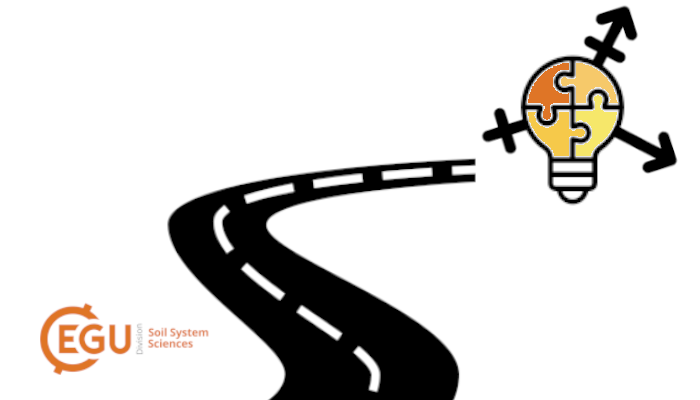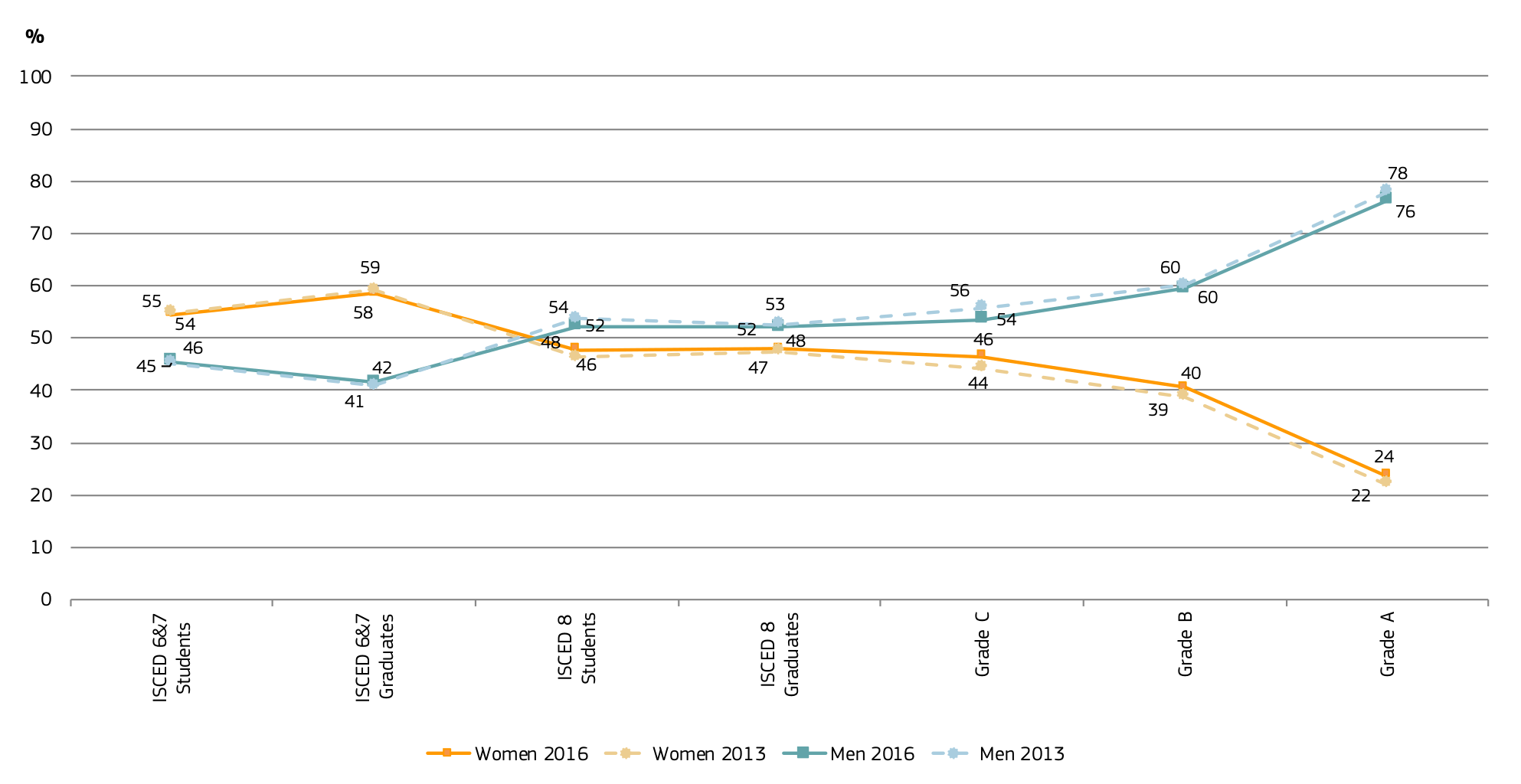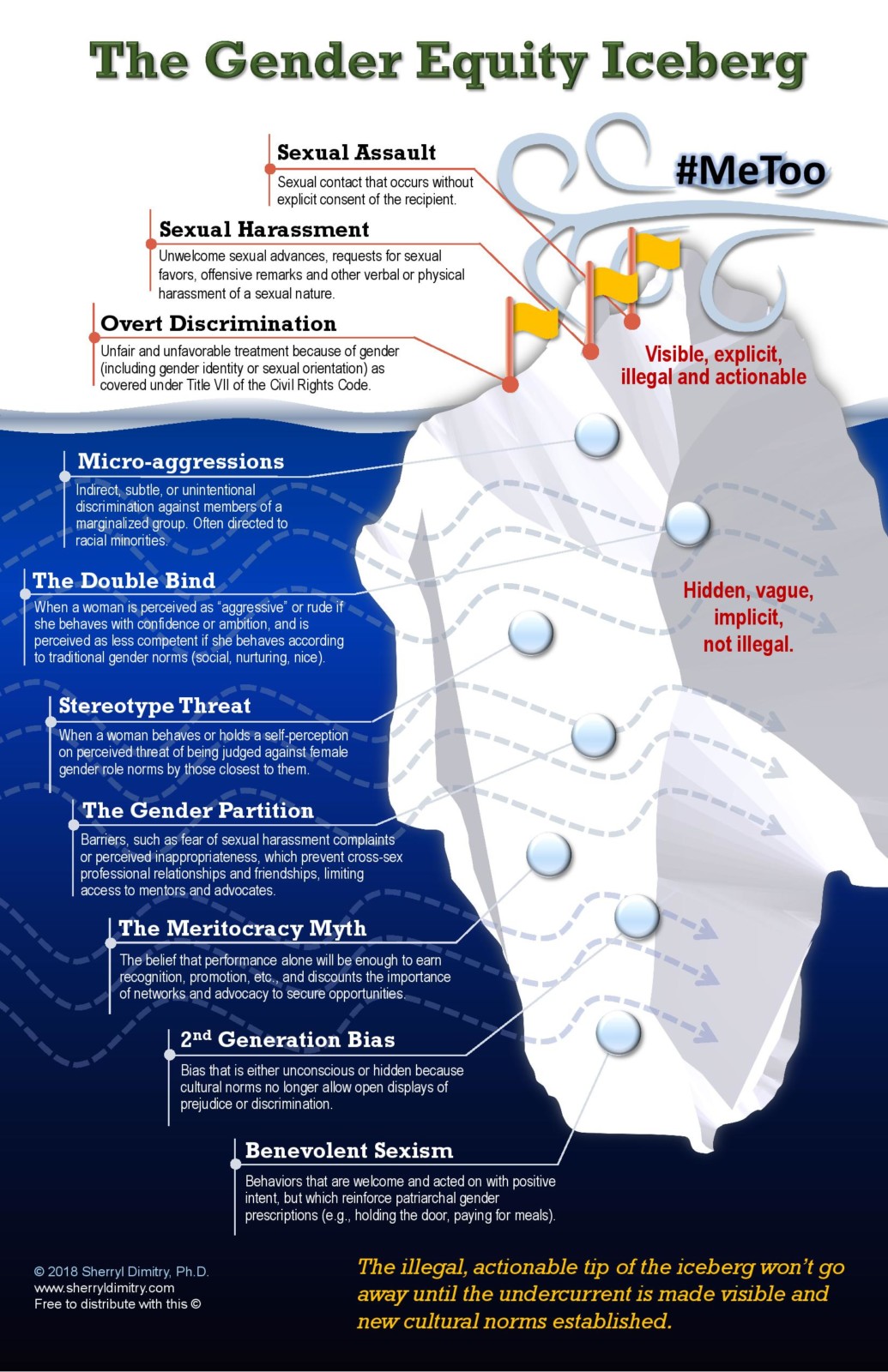
Today, as we celebrate International Women’s Day, let’s take a moment to acknowledge our progress in the challenge of reaching gender equity in science, and soil science in particular. Despite the crucial contributions of women, and the fact that an increased gender diversity can contribute to the collective worldwide performance [1], women remain underrepresented and face gender bias in science while we are only starting to learn about the experience of trans and gender diverse individuals. Positive disclaimer: The situation *is* improving.
A few numbers first…
Despite holding nearly half of the advanced soil science degrees, women represent only 24% of the soil scientists in academic faculty positions in the US [2]. Comparable discipline-specific data for Europe are lacking but a similar “leaky pipeline” is visible across disciplines and EU countries (Fig. 1). In fact, women represent 46% of the doctoral graduates in natural sciences, mathematics and statistics, and even outnumber men (59%) in agriculture, forestry, fisheries and veterinary fields combined [3]. However, further up the career ladder in higher education, women representation decreases to 38 and 48% of researchers in natural and agricultural sciences, respectively (based on SHE FIGURES 2018, EU-28 without FR, CY, LU, MT, year 2015). In the government sector, the situation is comparatively better, with women representing 41 and 51% of researchers in natural and agricultural sciences, respectively. On the bright side, it is relevant to say that the representation of women in both of these broader fields has been increasing in most EU countries (on average by 3% between 2008 and 2015).

Fig.1 Proportion (%) of men and women in a typical academic career, students, and academic staff, EU-28, 2013-2016 Credit: SHE FIGURES, 2018, Fig. 6.1
2020: challenges and positive outcomes
While the representation of women in science is improving, 2020 has proved to us again that we are driving along a bumpy road. For example, in November 2020, a paper published in Nature Communications suggested that having a woman as a promotor or supervisor might hamper the careers of young scientists. When it was eventually retracted because of strong public criticism (i.e. for poor methodology, poor statistical inference, lacking and narrow definitions for mentorship, a lacking discussion and an insufficient addressment of reviewer comments) it left us with mixed feelings – touched by the vigilance of the scientific community but still disenchanted by the fact that it was published in the first place. Furthermore, studies suggest that the Covid-19 pandemic has been disproportionately affecting female academics [4] and women in general. Although all researchers with care-giving responsibilities experienced an increased burden, women have experienced larger increases than men [4].
Searching for positivity, 2020 has also brought us the “Picture a Scientist” movie that – through the experiences of three female scientists – further shed light on women’s struggles in natural sciences and helped fuel the public debate on gender equity across campuses. We can also look forward to the “Will Run for Soil” movie about three women with a passion for both soil science and running.
Meet gender bias…
We already know a lot about the obstacles on our road to gender equity. Visible, explicit and illegal actions, such as sexual assualt or overt discrimination, are only the tip of the gender equity iceberg (Fig. 2). Gender bias affects both women and men usually through more hidden and subtle ways of unconscious – also called “implicit”- bias, the core of which is rooted in our societal norms that we start absorbing during childhood.

Fig. 2 The Gender Equity Iceberg. Credit: DimitryMurphy & Associates
For instance, when asked to draw a scientist, children are more likely to draw a male [5,6]. However, children (mostly girls) tend to draw female scientists more and more often; a trend which decreases as girls become older [5]. As early as age 6, girls begin to view fewer members of their gender as “really, really smart” [7]. In addition, they also begin to avoid activities which are said to be for “really, really smart” children [7]. This phenomenon continues during adolescence, when girls’ self-concepts of their science and math abilities continue to become less stable than those of boys [8]. According to the self-objectification theory, adolescent girls start to constantly assess their bodies in an effort to conform to the culture’s standards of attractiveness and this may leave fewer cognitive resources available [9]. For example, while alone in a dressing room, female undergraduates in swimsuits performed significantly worse on math problems than female undergraduates wearing sweaters, while no differences were found for men [10]. Similar effects were later found for other cognitive abilities such as logical reasoning and spatial skills [11] but also for men, suggesting that self-objectification can impact everyone [12]. Single-sex math classes lead girls to feel less self-conscious and improve their math performance substantially [13].
The career paths of young women are influenced by what can be summarized as “You can’t be what you can’t see” (Fig. 3). The gender-science stereotype, i.e. how much people associate women and men with science, can be measured as explicit bias (asking people that question directly) or implicit bias (using the Gender-Science Implicit Association Test). When compared among 66 countries, the gender-science stereotype has been directly related to the percentage of women researchers in that country (in the case of explicit bias) and the percentage of women enrolled in tertiary science education (for both implicit and explicit bias) [14]. Also, others have shown that a lack of female leaders supports women’s automatic gender stereotyping [15]. The impact of such implicit bias is powerful as, for example, girls living in countries with strong gender-science stereotypes perform poorer in 8th grade math and science tests [16]. If this leads to a drop of interest and/or confidence of girls to pursue a career in science, the whole cycle could be self-perpetuating (Fig. 3).
At work…
In contrast with explicit bias, which is conscious and deliberate, implicit associations can activate discriminatory responses independent of our conscious beliefs [17]. For example, committees with implicit bias can promote fewer women, if they are not aware of their bias [18]. Women can be interrupted in job interviews more often [19], perceived as less competent, even by other women [20], receive less funding [21,22], get paid less [20,23] and even less so when they become mothers (known as the “motherhood penalty”) [24]. But it’s not only these external factors that can limit women’s success in science. Conforming to (internalized) gender roles, such as being “quiet, nice, humble and caregiving” may give a comparative disadvantage in a game where the winners are determined based on individual success, favouring competitiveness and self-promotion rather than collaboration, human experience, quality of education, etc. For example, women ask fewer questions in seminars [25] and talk less in formal contexts than men [26]. Women may face various double binds, e.g., low-pitched voice is perceived more persuasive [27] but can be seen as less attractive in women in contrast to men, whose deeper voices are considered more attractive [28]. However, similar impacts can be expected in all individuals who do not hold up to the norms of status quo, irrespective of their gender.
And at home…
Women’s experience at home also differs from that of men. Female academics are less likely to have a stay-at-home partner or partner not working full-time [29,30]. Female academics, more than male academics, tend to work part-time [31] and tend to be married to other faculty members [29]. Women spend more time on domestic activities and are more likely to take time-off in case of unusual changes in arranged child care [30], which could be the underlying reason why the Covid-19 pandemic seems to have affected female researchers more.
Taking action
Although reaching true gender equality seems to be a long-term goal, tools to raise awareness and increase representation of women in science are already available and are bringing results. But let’s not rest on our laurels, there is still much to be done. Further attention should be, for example, given to how other forms of diversity such as race, sexuality or language interact with gender, because members of multiple-minority groups experience even greater inequality [32].
The European Geosciences Union (EGU) contributes to gender diversity as well as other forms of diversity in multiple ways. For example, gender balance is strongly supported in convener teams, presenters, committee members, awardees and medalists – e.g. in the SSS Division, women represent 50% of the Division structure. Since 2018, the Equality, Diversity, and Inclusion Working Group of EGU has been active and promoting gender equality through multiple activities. As every year, you can look forward to several sessions and short courses dedicated to this topic at the next General Assembly.
Further resources:
- Women in Soil Science list
- Promoting inclusive language guide: an incomplete guide, version 2
- 500 Women Scientists
- AdvanceGEO
-
Glossary & Thesaurus of the European Institute for Gender Equality
References
[*] Featured image created by Olga Vindušková using icons created by Adrien Coquet, Sergey Krivoy, and Arthur Shlain from Noun Project
1. See studies 2- 16 here
2. Vaughan, K. et al. Women in Soil Science: Growing Participation, Emerging Gaps, and the Opportunities for Advancement in the USA. Soil Sci. Soc. Am. J. 83, 1278–1289 (2019).
3. SHE FIGURES 2018. https://ec.europa.eu/info/publications/she-figures-2018_en.
4. Deryugina, T., Shurchkov, O. & Stearns, J. COVID-19 Disruptions Disproportionately Affect Female Academics. http://www.nber.org/papers/w28360.pdf (2021) doi:10.3386/w28360.
5. Miller, D. I., Nolla, K. M., Eagly, A. H. & Uttal, D. H. The Development of Children’s Gender-Science Stereotypes: A Meta-analysis of 5 Decades of U.S. Draw-A-Scientist Studies. Child Dev. 89, 1943–1955 (2018).
6. Ferguson, S. L. & Lezotte, S. M. Exploring the state of science stereotypes: Systematic review and meta‐analysis of the Draw‐A‐Scientist Checklist. Sch. Sci. Math. 120, 55–65 (2020).
7. Bian, L., Leslie, S. J. & Cimpian, A. Gender stereotypes about intellectual ability emerge early and influence children’s interests. Science 355, 389–391 (2017).
8. Linver, M. R. & Davis-Kean, P. E. The slippery slope: What predicts math grades in middle and high school? New Dir. Child Adolesc. Dev. 2005, 49–64 (2005).
9. Daniels, E. A., Zurbriggen, E. L. & Monique Ward, L. Becoming an object: A review of self-objectification in girls. Body Image vol. 33 278–299 (2020).
10. Fredrickson, B. L., Roberts, T.-A., Noll, S. M., Quinn, D. M. & Twenge, J. M. That swimsuit becomes you: Sex differences in self-objectification, restrained eating, and math performance. J. Pers. Soc. Psychol. 75, 269–284 (1998).
11. Gapinski, K. D., Brownell, K. D. & LaFrance, M. Body objectification and ‘fat talk’: Effects on emotion, motivation, and cognitive performance. Sex Roles 48, 377–388 (2003).
12. Hebl, M. R., King, E. B. & Lin, J. The swimsuit becomes us all: Ethnicity, gender, and vulnerability to self-objectification. Personality and Social Psychology Bulletin vol. 30 1322–1331 (2004).
13. Eisenkopf, G., Hessami, Z., Fischbacher, U. & Ursprung, H. W. Academic performance and single-sex schooling: Evidence from a natural experiment in Switzerland. J. Econ. Behav. Organ. 115, 123–143 (2015).
14. Miller, D. I., Eagly, A. H. & Linn, M. C. Women’s representation in science predicts national gender-science stereotypes: Evidence from 66 nations. J. Educ. Psychol. 107, 631–644 (2015).
15. Dasgupta, N. & Asgari, S. Seeing is believing: Exposure to counterstereotypic women leaders and its effect on the malleability of automatic gender stereotyping. J. Exp. Soc. Psychol. 40, 642–658 (2004).
16. Nosek, B. A. et al. National differences in gender-science stereotypes predict national sex differences in science and math achievement. Proc. Natl. Acad. Sci. U. S. A. 106, 10593–10597 (2009).
17. Greenwald, A. G., Poehlman, T. A., Uhlmann, E. L. & Banaji, M. R. Understanding and Using the Implicit Association Test: III. Meta-Analysis of Predictive Validity. J. Pers. Soc. Psychol. 97, 17–41 (2009).
18. Régner, I., Thinus-Blanc, C., Netter, A., Schmader, T. & Huguet, P. Committees with implicit biases promote fewer women when they do not believe gender bias exists. Nat. Hum. Behav. 3, 1171–1179 (2019).
19. Blair-Loy, M. et al. Gender in Engineering Departments: Are There Gender Differences in Interruptions of Academic Job Talks? Soc. Sci. 6, 29 (2017).
20. Moss-Racusin, C. A., Dovidio, J. F., Brescoll, V. L., Graham, M. J. & Handelsman, J. Science faculty’s subtle gender biases favor male students. Proc. Natl. Acad. Sci. U. S. A. 109, 16474–16479 (2012).
21. Tamblyn, R., Girard, N., Qian, C. J. & Hanley, J. Assessment of potential bias in research grant peer review in Canada. CMAJ 190, E489–E499 (2018).
22. Van Der Lee, R., Ellemers, N. & Fiske, S. T. Gender contributes to personal research funding success in The Netherlands. Proc. Natl. Acad. Sci. U. S. A. 112, 12349–12353 (2015).
23. Begeny, C. T., Ryan, M. K., Moss-Racusin, C. A. & Ravetz, G. In some professions, women have become well represented, yet gender bias persists—Perpetuated by those who think it is not happening. Sci. Adv. 6, eaba7814 (2020).
24. Charlesworth, T. E. S. & Banaji, M. R. Gender in Science, Technology, Engineering, and Mathematics: Issues, Causes, Solutions. Journal of Neuroscience vol. 39 7228–7243 (2019).
25. Carter, A. J., Croft, A., Lukas, D. & Sandstrom, G. M. Women’s visibility in academic seminars: Women ask fewer questions than men. PLoS One 13, e0202743 (2018).
26. James, D. & Drakich, J. Understanding gender differences in amount of talk: A critical review of research. undefined (1993).
27. Wang, D., Zhang, B., Zhu, L., Yang, Y. & Li, M. Soil and vegetation development along a 10-year restoration chronosequence in tailing dams in the Xiaoqinling gold region of Central China. CATENA 167, 250–256 (2018).
28. Borkowska, B. & Pawlowski, B. Female voice frequency in the context of dominance and attractiveness perception. Anim. Behav. 82, 55–59 (2011).
29. Schiebinger, L., Davies Henderson, A. & Gilmartin, S. K. Dual-Career Academic Couples What Universities Need to Know. (2008).
30. Jolly, S. et al. Gender differences in time spent on parenting and domestic responsibilities by high-achieving young physician-researchers. Ann. Intern. Med. 160, 344–353 (2014).
31. Waaijer, C. J. F., Sonneveld, H., Buitendijk, S. E., van Bochove, C. A. & van der Weijden, I. C. M. The Role of Gender in the Employment, Career Perception and Research Performance of Recent PhD Graduates from Dutch Universities. PLoS One 11, e0164784 (2016).
32. Miller, C. & Roksa, J. Balancing Research and Service in Academia: Gender, Race, and Laboratory Tasks. Gend. Soc. 34, 131–152 (2020).
Acknowledgments
Authors thank Yvonne Toynton Kullberg for proofreading this blog post.

